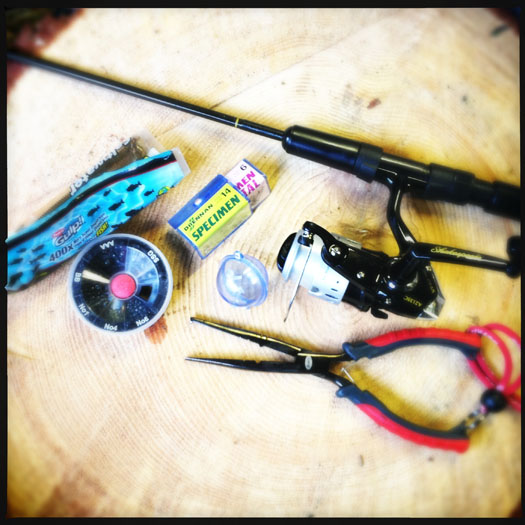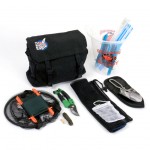Here we show you how to set up a simple float and bait fishing rig.
You will need:
- a simple fishing rod and reel
- Line for the reel should be around 16lbs strength for most fish
- A selection of hooks from small to medium
- Pair of pliers for clamping down the barbs
- A selection of weights
- A round bobber
- A selection of baits such as maggots, GULP! fake-baits or even worms
Flick the bar of the reel so the line can come off freely and thread the line through the eyelets.
Bring the line so it comes back to the reel and put the rod down somewhere where it is safe and won’t get stepped on. Flick the bar back over so now more line will be released.
Depending on the type of float, thread the line through the float and try and guess how deep the water is. Move the float so the end of the line where the hook will be is about half a metre off the bottom.
Tie the fishing line into a small or medium sized hook. The best knot to use is called the half blood knot or a cinch knot. We have produced a guide showing you how to tie a half blood knot (cinch knot).
Once you have your hook on your line, use a pair of pliers to clamp the barbs down. This makes the hook much safer when you are fishing with children.
Attach a medium size weight to the line about 6 cms above the hook. Place your bait on the hook. If this is a maggot or a worm you have to really skewer it onto the hook and make sure it is secure.
Take the rod and reel the line back in so the hook and bobber is hanging about half a metre from the tip of the rod. Bring the rod out to the side of you, grip the line with your finger to hold it in place, flick the bar on the reel so the line is free to run and flick the spinner as far as you can into the water. Flick the bar back and start reeling in the slack until the line is tight.
Wait.
Wait some more.
Then when you are sure nothing is happening, cast again in a slightly different direction.
If you do get it stuck on the retrieve, try and pull the line free from different angles – if you can go 90 degrees from the direction you were originally pulling it may come free. If the worst happens and it is completely stuck, don’t fret about it. Pull the line very firmly with your hands, not the rod. This way if it suddenly comes free you will not have a hook flying back at you at great speed! Pull hard until either it comes loose, the line snaps or the hook bends. If the hook is bent, use your pliers to bend it back into shape.
Watch the float and if you notice a bob-bob-bob, raise the rod upwards firmly (this is called setting the hook). If you feel a wobbling on the line you have caught a fish! If not, set back. If there is a fish, keep the rod tip up and start reeling in at a steady speed. If the fish makes a dart for it, try and steer it back to you by moving the rod from left to right. To land the fish try and guide it head up into a net or onto the bank.
Don’t handle the fish too much. Unless you are fishing for food, in which case whack it firmly on the top of the head and try one the Mighty Eagle fish recipes!
If you are releasing the fish, wet your hands before holding it and remove the hook using the pliers. Take a picture and place it gently back in the water. You may have to hold the fish by the tail to let it get some water back through its gills, and then it should start to move and swim off.
If you want to learn more about foraging you may be interested in this item:
Foraging Kit
The Mighty Eagle Foraging Kit, is the best way to get you started finding for your own food.
Simple chores like taking the dog out for a walk, can become fine food expeditions. You and your kids can get to chew your way through, blackberries, wild strawberries or Porcine mushrooms. The kit has a fully researched and full colour instruction leaflet, which will get you on your way, and tell you what is in season and when. More Info
One response to “How to set up a simple float and bait fishing rig”
Leave a Reply
You must be logged in to post a comment.








Aleta Nitschke liked this on Facebook.